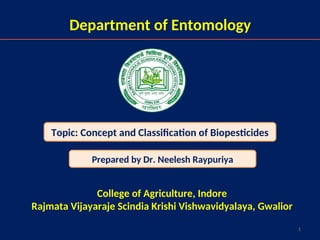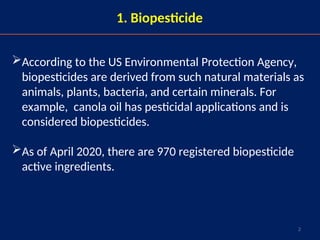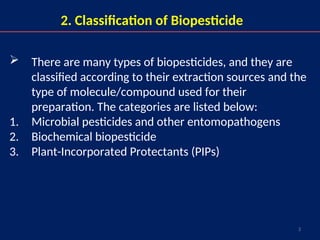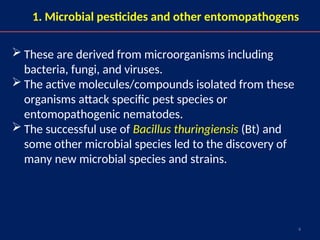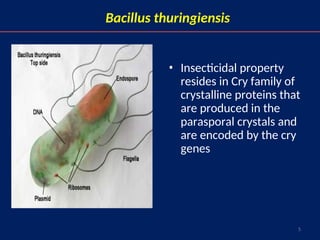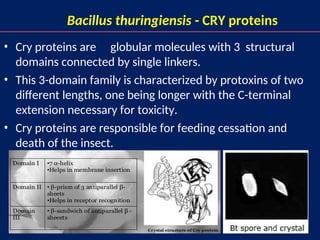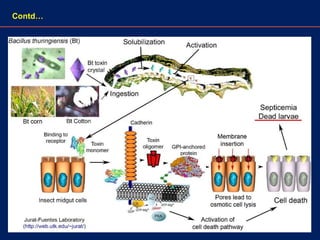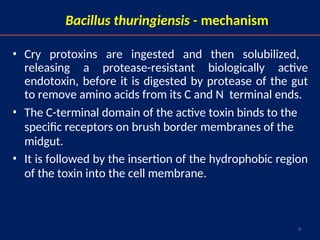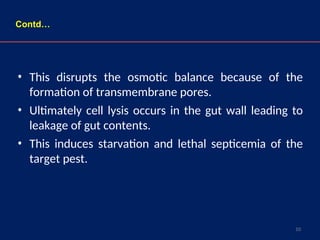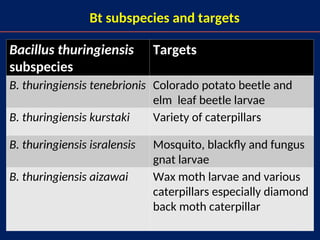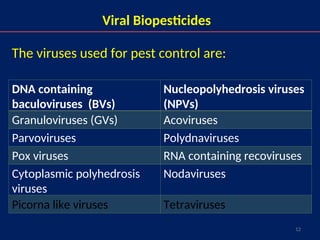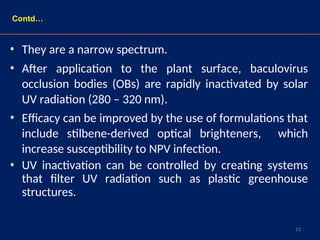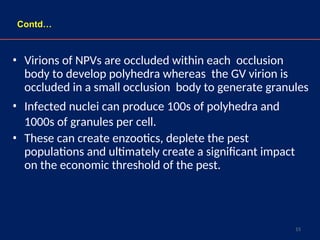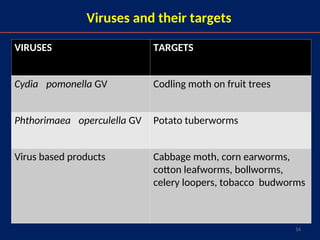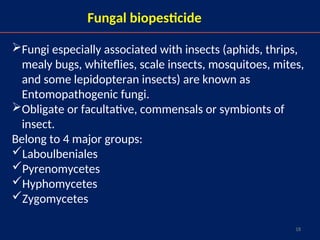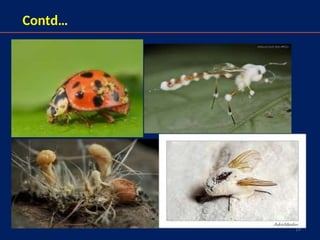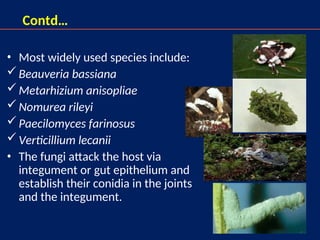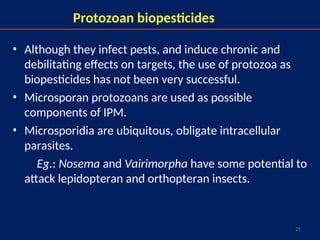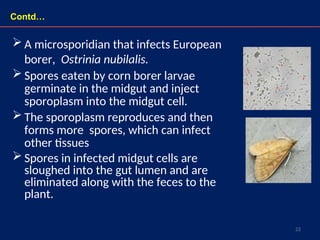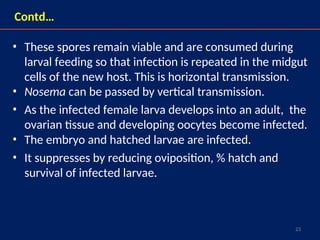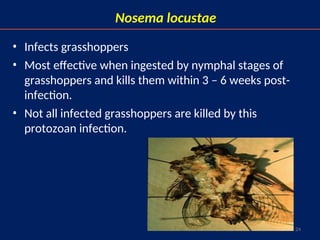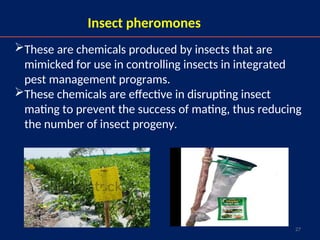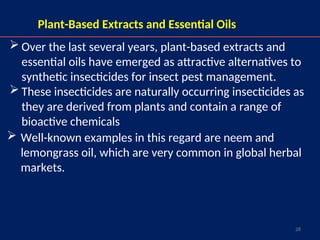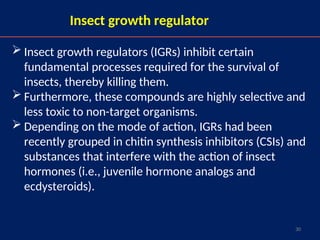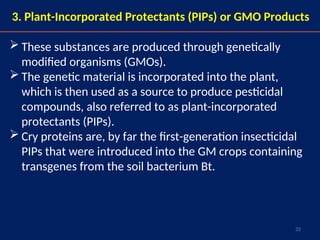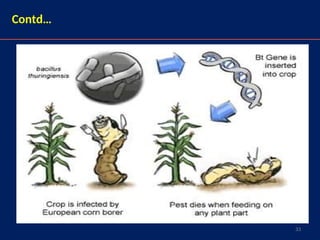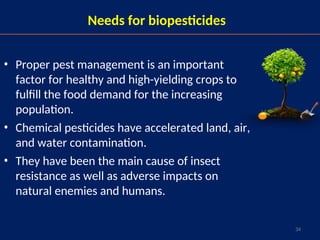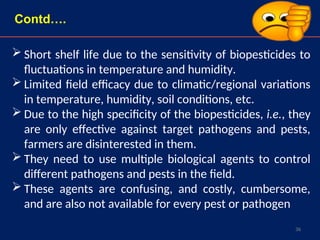types of biopesticides classification.ppt
- 1. 1 Topic: Concept and Classification of Biopesticides Prepared by Dr. Neelesh Raypuriya College of Agriculture, Indore Rajmata Vijayaraje Scindia Krishi Vishwavidyalaya, Gwalior Department of Entomology
- 2. 2 1. Biopesticide ´âÿAccording to the US Environmental Protection Agency, biopesticides are derived from such natural materials as animals, plants, bacteria, and certain minerals. For example, canola oil has pesticidal applications and is considered biopesticides. ´âÿAs of April 2020, there are 970 registered biopesticide active ingredients.
- 3. 3 2. Classification of Biopesticide ´âÿ There are many types of biopesticides, and they are classified according to their extraction sources and the type of molecule/compound used for their preparation. The categories are listed below: 1. Microbial pesticides and other entomopathogens 2. Biochemical biopesticide 3. Plant-Incorporated Protectants (PIPs)
- 4. 4 1. Microbial pesticides and other entomopathogens ´âÿ These are derived from microorganisms including bacteria, fungi, and viruses. ´âÿ The active molecules/compounds isolated from these organisms attack specific pest species or entomopathogenic nematodes. ´âÿ The successful use of Bacillus thuringiensis (Bt) and some other microbial species led to the discovery of many new microbial species and strains.
- 5. 5 Bacillus thuringiensis ÔÇó Insecticidal property resides in Cry family of crystalline proteins that are produced in the parasporal crystals and are encoded by the cry genes
- 6. 6 Bacillus thuringiensis - CRY proteins ÔÇó Cry proteins are globular molecules with 3 structural domains connected by single linkers. ÔÇó This 3-domain family is characterized by protoxins of two different lengths, one being longer with the C-terminal extension necessary for toxicity. ÔÇó Cry proteins are responsible for feeding cessation and death of the insect.
- 7. 7 Mode of action of Bt
- 8. 8 Contd
- 9. 9 Bacillus thuringiensis - mechanism ÔÇó Cry protoxins are ingested and then solubilized, releasing a protease-resistant biologically active endotoxin, before it is digested by protease of the gut to remove amino acids from its C and N terminal ends. ÔÇó The C-terminal domain of the active toxin binds to the specific receptors on brush border membranes of the midgut. ÔÇó It is followed by the insertion of the hydrophobic region of the toxin into the cell membrane.
- 10. 10  This disrupts the osmotic balance because of the formation of transmembrane pores.  Ultimately cell lysis occurs in the gut wall leading to leakage of gut contents.  This induces starvation and lethal septicemia of the target pest. Contd
- 11. 11 Bt subspecies and targets Bacillus thuringiensis subspecies Targets B. thuringiensis tenebrionis Colorado potato beetle and elm leaf beetle larvae B. thuringiensis kurstaki Variety of caterpillars B. thuringiensis isralensis Mosquito, blackfly and fungus gnat larvae B. thuringiensis aizawai Wax moth larvae and various caterpillars especially diamond back moth caterpillar
- 12. 12 Viral Biopesticides The viruses used for pest control are: DNA containing baculoviruses (BVs) Nucleopolyhedrosis viruses (NPVs) Granuloviruses (GVs) Acoviruses Parvoviruses Polydnaviruses Pox viruses RNA containing recoviruses Cytoplasmic polyhedrosis viruses Nodaviruses Picorna like viruses Tetraviruses
- 13. 13  They are a narrow spectrum.  After application to the plant surface, baculovirus occlusion bodies (OBs) are rapidly inactivated by solar UV radiation (280  320 nm).  Efficacy can be improved by the use of formulations that include stilbene-derived optical brighteners, which increase susceptibility to NPV infection.  UV inactivation can be controlled by creating systems that filter UV radiation such as plastic greenhouse structures. Contd
- 14. 14 Contd
- 15. 15  Virions of NPVs are occluded within each occlusion body to develop polyhedra whereas the GV virion is occluded in a small occlusion body to generate granules  Infected nuclei can produce 100s of polyhedra and 1000s of granules per cell.  These can create enzootics, deplete the pest populations and ultimately create a significant impact on the economic threshold of the pest. Contd
- 16. 16 Viruses and their targets VIRUSES TARGETS Cydia pomonella GV Codling moth on fruit trees Phthorimaea operculella GV Potato tuberworms Virus based products Cabbage moth, corn earworms, cotton leafworms, bollworms, celery loopers, tobacco budworms
- 17. 17 Viruses and their targets VIRUSES TARGETS Cydia pomonella GV Codling moth on fruit trees Phthorimaea operculella GV Potato tuberworms Virus based products Cabbage moth, corn earworms, cotton leafworms, bollworms, celery loopers, tobacco budworms
- 18. 18 Fungal biopesticide ´âÿFungi especially associated with insects (aphids, thrips, mealy bugs, whiteflies, scale insects, mosquitoes, mites, and some lepidopteran insects) are known as Entomopathogenic fungi. ´âÿObligate or facultative, commensals or symbionts of insect. Belong to 4 major groups: ´â╝Laboulbeniales ´â╝Pyrenomycetes ´â╝Hyphomycetes ´â╝Zygomycetes
- 19. 19 Contd
- 20. 20 ContdÔǪ ÔÇó Most widely used species include: ´â╝Beauveria bassiana ´â╝Metarhizium anisopliae ´â╝Nomurea rileyi ´â╝Paecilomyces farinosus ´â╝Verticillium lecanii ÔÇó The fungi attack the host via integument or gut epithelium and establish their conidia in the joints and the integument.
- 21. 21 Protozoan biopesticides ÔÇó Although they infect pests, and induce chronic and debilitating effects on targets, the use of protozoa as biopesticides has not been very successful. ÔÇó Microsporan protozoans are used as possible components of IPM. ÔÇó Microsporidia are ubiquitous, obligate intracellular parasites. Eg.: Nosema and Vairimorpha have some potential to attack lepidopteran and orthopteran insects.
- 22. 22 ´âÿ A microsporidian that infects European borer, Ostrinia nubilalis. ´âÿ Spores eaten by corn borer larvae germinate in the midgut and inject sporoplasm into the midgut cell. ´âÿ The sporoplasm reproduces and then forms more spores, which can infect other tissues ´âÿ Spores in infected midgut cells are sloughed into the gut lumen and are eliminated along with the feces to the plant. ContdÔǪ
- 23. 23 Contd  These spores remain viable and are consumed during larval feeding so that infection is repeated in the midgut cells of the new host. This is horizontal transmission.  Nosema can be passed by vertical transmission.  As the infected female larva develops into an adult, the ovarian tissue and developing oocytes become infected.  The embryo and hatched larvae are infected.  It suppresses by reducing oviposition, % hatch and survival of infected larvae.
- 24. 24 Nosema locustae ÔÇó Infects grasshoppers ÔÇó Most effective when ingested by nymphal stages of grasshoppers and kills them within 3 ÔÇô 6 weeks post- infection. ÔÇó Not all infected grasshoppers are killed by this protozoan infection.
- 25. 25 Microbial Products in Biopesticides ÔÇó Some transgenic crops can be considered among microbial-based products ÔÇó Eg:- Bacillus thuringiensis-based genetically engineered crops like Bt cotton and maize. ÔÇó Genetically modified (GM) sugar beet, papaya, sweet pepper, tomato, etc. are successfully grown.
- 26. 26 2. Biochemical biopesticide ´âÿ Biochemical pesticides are naturally occurring products that are used to control pests through nontoxic mechanisms, whereas chemical pesticides use synthetic molecules that directly kill pests. Biochemical pesticides are further classified into different types: 1. Insect Pheromones 2. Plant-Based Extracts and Essential Oils 3. Insect Growth Regulators
- 27. 27 Insect pheromones ´âÿThese are chemicals produced by insects that are mimicked for use in controlling insects in integrated pest management programs. ´âÿThese chemicals are effective in disrupting insect mating to prevent the success of mating, thus reducing the number of insect progeny.
- 28. 28 Plant-Based Extracts and Essential Oils ´âÿ Well-known examples in this regard are neem and lemongrass oil, which are very common in global herbal markets. ´âÿ Over the last several years, plant-based extracts and essential oils have emerged as attractive alternatives to synthetic insecticides for insect pest management. ´âÿ These insecticides are naturally occurring insecticides as they are derived from plants and contain a range of bioactive chemicals
- 29. 29 ´âÿ However, it is very important to determine the dose of azadirachtin content in neem oil so as not to kill the nontarget organisms. ´âÿ A comprehensive study by Halder et al. showed that a combination of neem oil with entomopathogenic microorganisms, including Beauveria bassiana, was very successful against vegetable-sucking pests. ContdÔǪ
- 30. 30 Insect growth regulator ´âÿ Insect growth regulators (IGRs) inhibit certain fundamental processes required for the survival of insects, thereby killing them. ´âÿ Furthermore, these compounds are highly selective and less toxic to non-target organisms. ´âÿ Depending on the mode of action, IGRs had been recently grouped in chitin synthesis inhibitors (CSIs) and substances that interfere with the action of insect hormones (i.e., juvenile hormone analogs and ecdysteroids).
- 31. 31 ´âÿ IGRs can control many types of insects including fleas, cockroaches, and mosquitos even though they are not so fatal for adult insects. ContdÔǪ We examine the insecticidal effects of diflubenzuron (DFB) in Tribolium castaneum.
- 32. 32 3. Plant-Incorporated Protectants (PIPs) or GMO Products ´âÿ These substances are produced through genetically modified organisms (GMOs). ´âÿ The genetic material is incorporated into the plant, which is then used as a source to produce pesticidal compounds, also referred to as plant-incorporated protectants (PIPs). ´âÿ Cry proteins are, by far the first-generation insecticidal PIPs that were introduced into the GM crops containing transgenes from the soil bacterium Bt.
- 33. 33 Contd
- 34. 34 Needs for biopesticides ÔÇó Proper pest management is an important factor for healthy and high-yielding crops to fulfill the food demand for the increasing population. ÔÇó Chemical pesticides have accelerated land, air, and water contamination. ÔÇó They have been the main cause of insect resistance as well as adverse impacts on natural enemies and humans.
- 35. 35 They are environmentally friendly, target specific, and not deleterious to nontarget organisms and hence potent enough to replace synthetic pesticides for pest management. However, despite the merits of using biopesticides, their use has not been as widespread as expected, for the following reasons: ´âÿHigh cost of pesticide production due to the costs involved in screening, developing, and getting regulatory clearance for new biological agents. Merits of Biopesticides over Chemical Pesticides
- 36. 36 ´âÿ Short shelf life due to the sensitivity of biopesticides to fluctuations in temperature and humidity. ´âÿ Limited field efficacy due to climatic/regional variations in temperature, humidity, soil conditions, etc. ´âÿ Due to the high specificity of the biopesticides, i.e., they are only effective against target pathogens and pests, farmers are disinterested in them. ´âÿ They need to use multiple biological agents to control different pathogens and pests in the field. ´âÿ These agents are confusing, and costly, cumbersome, and are also not available for every pest or pathogen ContdÔǪ.
- 37. 37
